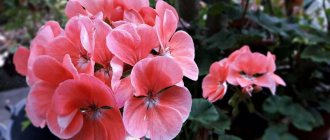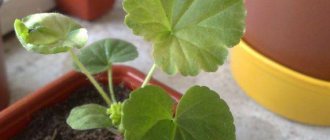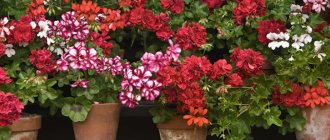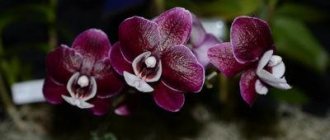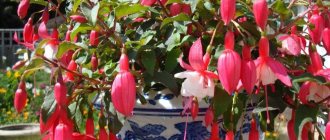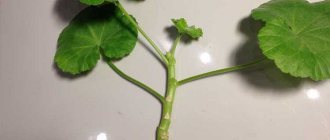Pelargonium from the geranium family is called indoor geranium by almost all gardeners. There is also outdoor geranium, which differs from pelargonium in the shape of leaves and flowers, resistance to frost, method of reproduction and growing area. You can learn about the difference between pelargonium and geranium on our website from the article “What is the difference between geranium and pelargonium“.
Indoor and outdoor geraniums are always dotted with flowers, growing alternately and emitting an aroma that cannot be confused with the smell of other flowers. Their leaves are also endowed with a special aroma. Because of this, both plants are used by the cosmetic industry to obtain essential oils. However, these plants should not be left unattended during development, growth and flowering, as they may be susceptible to disease and damage from pest infestations.
But geranium diseases (see photo) and their treatment are similar for both indoor and outdoor representatives. This will be discussed in detail in this article, as well as disease prevention measures.
Black leg in pelargonium: can the plant be cured and methods of prevention
Blackleg is the most common and nasty disease that affects pelargoniums or home geraniums.
The plant can be saved only if the infection is detected in time. Often, black leg is diagnosed when pelargonium has already died. Until this time, the disease does not manifest itself in any way. In this issue, you will find a complete guide to what to do if you notice that the geranium stems have begun to rot and signs of fungus have appeared due to waterlogging. Black leg of pelargonium is an insidious disease. It quickly infects the entire plant. Blackleg disease manifests itself abruptly. The lower parts of the trunk turn black and become soft, which is characteristic of rotting. At the same time, the blackness begins to spread to the top and quickly stains at least half of the shoots. If the disease is not treated in a timely manner, the leaves become yellow and are easily separated.
Not a single type of geranium is immune from blackleg. But, if an illness happens to your flower, then read about other varieties that are perhaps more decorative than what you had at home: rosebud pelargoniums, tulip-shaped geraniums.
Common causes of the disease
The main factors that provoke various diseases in geranium are:
Symptoms and diagnoses
| External signs of illness | Causes | Disease | Pests |
| Yellowing and falling leaves | Lack of fresh air, drafts or excessive watering, excess nitrogen compounds in the soil | The initial period of development of root rot | This is how mealybugs can parasitize |
| The edges of the lower leaves turn yellow and dry out | The old leaves are dying off | Nutritional deficiencies | |
| Wet areas are visible on the stems, leaves wither | Stem rot | ||
| Lack of budding, yellow leaves | Increased temperature and humidity | Nutritional deficiencies | |
| Stopping plant growth | cramped potty | Lack of nitrogen, low soil acidity | Probability of mealybugs and whitefly |
| Wilting and drooping leaves | Lack of moisture in the soil | Fungal infection | |
| Swollen, watery blisters on foliage | Excess moisture in the soil | Eden | |
| Stopping growth and flowering | Advanced root rot | Root mealybug | |
| Uneven, overly elongated stem | Lack of light | Etiolation | |
| Round spots of light color, deforming leaves | Ring spot | ||
| White coating on foliage | Powdery mildew | ||
| Leaves turn yellow along the veins | Tobacco or tomato infection | ||
| Leaves take on a brownish tint | Excess fungicide | Excess phosphorus fertilizer | |
| The plant is covered with light green larvae and flying insects. | Whitefly |
Read about why the leaves of indoor geraniums turn red and dry out here, and from this article you will learn about why the leaves turn white and how to help the plant.
The most basic ailments
Most often, geranium is susceptible to various ailments due to poor care. The most common diseases of pelargonium are as follows:
WARNING: Fire burns cannot be treated. To save pelargonium from death, you need to pinch off all infected parts from a healthy shoot and burn them.
Geranium is very sensitive to waterlogged or unsterilized soil. When such unfavorable conditions arise, fungi, viruses and bacteria begin to parasitize it.
If infected, the diseased flower is isolated; for healthy plants, prevention is carried out, which includes the following steps:
We talked in detail about why leaf diseases occur in geraniums in this article.
Geranium can be affected by the following fungal infections:
Reasons for yellowing leaves of a flower in a pot in an apartment
Why does this happen on the tips of the leaves or along the edges?
- If you notice a yellow outline along the edges of the leaf blades, then most likely the matter is due to improper care.
This happens especially often in winter. Most often, yellowing occurs due to low air humidity, non-compliance with the watering regime (excessive amount of water or lack of it). - Also, the reason why yellowness appears at the edges is lower air temperatures; usually the leaf blades turn pale from the lower layers, gradually moving to the top. If rescue measures are not taken, the plant will quickly die.
- If a yellow outline appears in the summer, then most often the reason why this happened is that the air in the room is poorly humidified or the flower needs watering. Review the soil moisture regime and do not allow it to dry out completely.
- Sometimes the foliage turns yellow at the edges during the acclimatization period (for example, when the plant is moved from indoors to outdoors or vice versa). In this case, there is no need to worry - everything will be restored in a few days.
We talked in more detail about what to do if the geranium dries out and its leaves turn yellow around the edges here.
Why do yellow spots appear?
- Such processes most often indicate soil moistening with cold water.
- Sometimes contact with even the smallest drops leads to the appearance of fine yellow pigmentation. Try to water carefully, so that water does not splash on the stems and undersides of the leaf blades.
- Geranium does not tolerate strong humidity, so there is no need to spray it. For irrigation, prepare the water in advance - it should sit for at least 48 hours.
Geranium is one of the hardy plants that rarely gets sick. But still, there are factors that negatively affect the health of the home beauty. Let's call them:
- Tight flowerpot. Don't forget to regularly renew the geranium container. You need to focus on the state of the root system. It would be good if the pot was made of clay. The diameter of the flowerpot should be approximately 20-25 cm. But if the geranium is still very young, then choose a smaller container. A plastic pot causes the rhizome to rot.
- Incorrect watering schedule. The health of the plant depends entirely on the soil moisture regime.
A lot of water or a little can be determined even after examining the crop. If the foliage dries out and curls, this indicates a moisture deficiency. But if they begin to become covered with yellow spots, then this is a signal of waterlogging in the soil. Pay attention to the climate in the room. If the air is dry and hot, increase the amount of water. If the room is cool, then reduce the amount of watering. - Quality of irrigation liquid. Do not forget that the health of the plant depends not only on the frequency of watering, but also on the quality of the water. Experienced gardeners recommend using melt or rain water. The main thing is that the liquid does not contain various impurities, much less salts.
- Indoor air. Geranium loves well-warmed air in the room. The plant should be protected from low air temperatures, as well as changes in indicators. The optimal air temperature in summer ranges from 22-25 degrees above zero. In winter, it is allowed to reduce the air temperature to +15-+17 degrees.
- Soil condition. Geranium reacts negatively to the lack of a drainage layer. If there is no drainage, the root system will be constantly in moisture. Yellowing of the leaf blades is the first sign of rotting of the rhizomes.
- Infectious diseases or pest attacks. This happens rarely, but it can still happen. Most often, the crop becomes infected from neighboring plants. In any case, you cannot delay treatment, otherwise you may lose your indoor beauty. The fastest way to deal with illnesses and parasites is with chemicals.
Late blight of geranium
The plant stops blooming, quickly withers and rots, the leaves dry out. On the roots of a dead flower you can see spots with a depressed structure. She reaches up. Damaged areas are covered with gray mycelium. The pathogen is stored in the soil.
The cause of the disease is improper care. Too dense plantings, poor lighting, high air temperatures, too wet a substrate and a large amount of fertilizer - this is why the plant can get sick. All this prevents you from growing a good healthy plant.
To avoid disease, it is necessary to use loose substrates of exceptionally high quality and follow the rules of adequate ventilation. When the first signs appear, watering is stopped and treatment is carried out with Profit-Gold, Ridomil or Previkur. These products are considered the most suitable for pelargonium kept at home.
Harmful insects
The appearance of yellow spots on the leaves indicates that the flower is infected with harmful insects. It is recommended to carefully examine the flower and identify their presence in order to know how to save the geranium.
Caterpillars on pelargonium
- Mites live on the bottom of the leaf. On the leaf blade itself, small yellow spots first appear, which then dry out and become discolored. Appear at high air temperatures and dryness. It is recommended to treat the leaves with soapy water and special preparations.
- When aphids appear, the leaves turn yellow and curl, and there may be sticky discharge on them. You can also wash it off with soapy water. In case of severe damage, treat with special preparations.
- Traces of the presence of caterpillars are more visible than others. They leave black discharge and also chew out large areas on the leaves. You can manually collect insects, as well as treat them with biological insecticides.
Note! The appearance of pests is due to non-compliance with care rules, as well as the lack of comfortable conditions for the flower. After treating the plant, it is recommended to take preventive measures against the appearance of insects.
Flower pests
It is necessary to note a considerable number of geranium pests. Usually their occurrence is associated with increased dry air. Not only do they spoil the leaves by eating them, but they also provoke infections.
The smell of fragrant geranium is a unique way to combat aphids. These pests do not settle on pelargonium because of the smell that kills them. It’s not for nothing that experienced gardeners keep a pot of geraniums next to other flowers.
Whitefly
The whitefly is not as dangerous as its numerous larvae, which, feeding on the leaves, destroy the flower. A special product "Aktara", intended for watering, will help get rid of pests.
Spider mite
To combat this pest, we recommend removing all curled, damaged leaves. Wash the leaves of the flower with warm soapy water, and then cover the plant and pot with a plastic bag for 2-3 days. High humidity will kill ticks.
Termites
Termites are not at all dangerous for young geraniums, as they like to gnaw on the woody stem. Insecticides will help fight them. Please note that this type of medication is dangerous for pets. If there are cats, dogs, or birds at home, be vigilant.
Nematode
A real scourge from which there is no escape. The parasite promotes the formation of nodes on the roots. Treatment is impossible: the plant, pot, soil must be destroyed.
Root mealybug
The root bug settles in excessively wet soil and destroys the root. Then the stem is affected and the leaves begin to curl. In this case, only a transplant can help. The roots are thoroughly washed under running water, removing damaged ones, and planted in a new container.
Mealybug
The mealybug feeds on pelargonium sap, leaving sticky white clumps on the plant. Wipe the affected areas with a wet sponge and then spray with your homemade solution. To do this, take 20 ml of alcohol, 20 g of laundry soap and 1 liter of warm water - mix thoroughly (until completely dissolved).
Caterpillars
Caterpillars settle on geraniums if they are planted in open areas. The first sign of their appearance is holes on the foliage of the flower. Caterpillars are able to eat leaves until they destroy the plant. Experienced gardeners know how to get rid of caterpillars. For this they use the drug “Lepidocid”.
And here you can see a photo of geranium affected by diseases:
Source
Parasitic insects and their control
Pests attack an initially weak plant, achieving its complete death. The main parasites that affect geraniums are:
- Root mealybug . Appears if the soil is very moist. The insect eats the root system. To rehabilitate geraniums, the affected roots are cut off, after which the plant’s roots are immersed in hot water for several minutes. Then they are dried and sprinkled with charcoal. The root treated in this way is transferred to sterile soil.
- Mealybug . The pest looks like white lumps that suck the juices out of the plant. First of all, you need to isolate the flower and remove the white lumps with your hands. After this, spray the plant with a soap-alcohol solution.
- Whitefly . It can be found on the inside of the leaf. To remove it, the medicine Aktara is often used.
- Aphid . Most often it affects young plants. Its habitat is shoots, leaves and stems. Pests can be removed manually or by cutting off the affected stem.
- Caterpillar . The insect makes multiple holes in the stems into which it lays larvae. In this case, the drugs Senpai or Lipidocida help.
Attention! If the flower is on the verge of death, it is treated with insecticides such as Aktara, Aktellik or Fufanon.
We invite you to watch a video about pelargonium pests:
Pelargonium is sick: we diagnose, treat and revive bookmarks 5
This beautiful and unpretentious indoor, and if desired, garden plant with fragrant feathery or rounded leaves, with clusters of red or pink flowers, was loved by our great-grandmothers. We are, of course, talking about geranium, which is now more often called pelargonium. Previously, it was believed that this flower rarely got sick, and they didn’t bother with its treatment: after all, it’s very easy to grow a new bush from a cutting. Now pelargonists are actively discussing diseases and methods of treating their favorite plant at home, and everyone has a “green first aid kit.” What and why can indoor pelargonium be sick and how to help it?
Useful video
We invite you to watch a video about geranium diseases:
If you find an error, please select a piece of text and press Ctrl+Enter.
Pelargonium from the geranium family is called indoor geranium by almost all gardeners. There is also outdoor geranium, which differs from pelargonium in the shape of leaves and flowers, resistance to frost, method of reproduction and growing area. You can learn about the difference between pelargonium and geranium on our website from the article “What is the difference between geranium and pelargonium“.
Indoor and outdoor geraniums are always dotted with flowers, growing alternately and emitting an aroma that cannot be confused with the smell of other flowers. Their leaves are also endowed with a special aroma. Because of this, both plants are used by the cosmetic industry to obtain essential oils. However, these plants should not be left unattended during development, growth and flowering, as they may be susceptible to disease and damage from pest infestations.
But geranium diseases (see photo) and their treatment are similar for both indoor and outdoor representatives. This will be discussed in detail in this article, as well as disease prevention measures.
Home conditions for pelargonium
Pelargonium (aka geranium), which is grown on windowsills, is a native of the South African savannas. And like all Africans, she loves the sun and warmth very much, but has a negative attitude towards soil that is too nutritious and too wet. Rain is rare in the savannah, and the land there is poor.
In indoor floriculture, three types of pelargonium are known: zonal, royal (or royal) and ampelous. It is the zonal, or garden, geraniums that are planted in flower beds in the spring. They bloom for a very long time and reproduce without problems from cuttings. Royal pelargoniums are more whimsical. Their flowers are larger and more interesting than those of the zonal ones, but the flowering period is shorter and they are more difficult to reproduce. Ampelous geraniums are the most delicate and complex. But in general, pelargoniums are not very demanding and grateful flowers.
The characteristics of flowering southerners must be taken into account when growing them at home. Place pelargonium window sills on the south, east or west side. Plant it in a cramped pot so that it blooms better, give it not very nutritious soil with a good drainage layer.
Water rarely, but a lot, when it grows and blooms. But do not allow water to stagnate, remove excess water from the pan. In winter, only lightly moisten the soil; it should have time to dry out between waterings. There is no need to spray pelargonium; in nature it is not spoiled by high humidity. On the contrary, pubescent leaves can get sick if drops get on them. Be careful with fertilizing. Pelargonium can get sick from both lack of nutrition and excess. So keep your balance.
Blooming geranium needs fresh air all year round; ventilate the room where it grows. This is a good prevention of fungal diseases. In the summer, give the flower walks: put it in the fresh air or even plant it in open ground. The geranium will literally bloom there. In the fall, bring the whole plant or its cuttings home again.
Organize cool wintering, optimally from +10 to +15 degrees. And in winter, just as in summer, pelargonium needs plenty of light. If there is a deficiency, the leaves will be small, and flowering will be sparse or buds will not form at all. If there is not enough sun, artificial lighting (phytolamps, fluorescent or LED) will help.
Indoor geranium responds well to pinching and pruning. Form a fluffy bush in spring and summer, trim pelargonium for rejuvenation. And be sure to remove faded flower stalks so that new ones appear.
But don’t rush to transplant pelargonium from pot to pot. This plant is not prone to changing places. After relocation, she may turn yellow and become depressed so that resuscitation is required.
Why do pelargoniums start to get sick more often?
Once upon a time, flowering geraniums were considered very healthy plants and resistant to all sorts of ailments. Probably the fact is that flower growers did not even try to understand why the leaves suddenly turned yellow or red, and the buds and flowers withered. They simply broke off a branch and grew a new healthy plant, and threw away the old one. Now pelargonium has become more expensive, both figuratively and literally. Flower lovers become attached to their pets and do not want to lose them. And varietal types of pelargonium are not so little worth throwing at them.
At the same time, with the development of home floriculture, plants developed diseases that our grandmothers, who grew geraniums on the windowsill, did not even suspect. Oddly enough, progress is to blame. New varieties of pelargonium are very decorative; they bloom more brightly. And at the same time, they are more delicate and more easily infected with fungal or viral infections, and suffer more from care errors and metabolic diseases. Plant immunity has become much weaker. And fungi, viruses and pests are hardened, they mutate, adapting to modern drugs, and increase resistance. So it turns out that pelargonium lovers are forced to acquire special medicines and reference books to treat their flowers. But it is not all that bad. Pelargonium, which has been created in optimal conditions and is adequately cared for, will be healthy and certainly bloom.
Diseases and pests of pelargonium
Diseases of pelargonium can be divided into two large groups: non-infectious and infectious. Non-infectious diseases cause violations of the rules of care and metabolic processes of the plant. These are hypothermia, swelling, deficiency or excess of microelements, a reaction to chemicals. Infectious diseases are the result of infection by a fungus, bacteria or virus; these are various rots, spots, rust, powdery mildew, and blackleg. Such diseases are dangerous because they are easily transmitted from flower to flower. Therefore, when an infection is detected, it is necessary to urgently take quarantine measures to prevent infection and epidemics.
Pests are not too fond of pelargonium. For example, a punishment for flower growers - spider mites or scale insects rarely attack geraniums. Perhaps the specific aroma of the essential oil contained in the foliage of most plant species repels insects. But whiteflies, aphids, mealybugs and rootbugs are not bothered by this feature. And in the summer, when kept outside, geraniums are attacked by caterpillars.
Phytocontrol measures
It is easier to prevent a disease than to cure it; this principle of prevention also applies to plants. And her main rule is hygiene. A plant free from diseases and parasites and clean soil will be the key to healthy pelargonium. A flower can pick up an infection or parasite anywhere: in a nursery, in a store, in the soil. To protect your green pets, introduce home phytosanitary control. These measures will ensure the safety of the plants.
Preventive measures
To prevent geranium from getting sick, it is worth taking all possible measures to counteract bacterial and fungal diseases of the plant :
- the soil for growing geraniums should not be excessively wet and dense;
the amount of nutrients in the soil must fully cover the needs of the plant;- the soil should not be too saturated with nitrogen;
- before planting, you need to provide the soil with a good drainage system to protect the geranium from stagnation of moisture and, subsequently, root rot;
- Do not water the geranium using overhead watering and control it. so that moisture does not fall on the leaves of the plant;
- plants should be planted rarely, separately if possible;
- The soil must be regularly cleared of plant residues, as well as loosened and mulched.
Geranium diseases, treatment and prevention
Pelargoniums most often get sick due to waterlogging of the soil. It is the flooding of the plant that gives impetus to the development of various types of rot and spotting. The disease progresses especially quickly if the room is stale, stale air, too cold or, conversely, too hot. Pelargonium gets sick from a deficiency of microelements, but also from overfeeding. These problems weaken the immune system. As a result, the plant becomes more easily infected with fungal or viral infections.
Problems caused by metabolic disorders and care errors
Diseases related to care and metabolism are not contagious. Plants with etiolation, chlorosis, deficiency or excess of nutrients are not sent to quarantine. But these ailments cannot be left without treatment, because sooner or later they will lead to more serious problems.
Etiolation is a disease of light deficiency. If pelargonium does not have enough light, it stretches unsightly, the leaves become smaller and lighter. Such a plant will not bloom. It is not difficult to cure: place the geranium on the sunny side, and in winter add artificial lighting. Just be careful, get used to bright light gradually so that there are no burns. In addition, for the harmonious formation of a flower, it is useful to turn it towards the light with different sides.
Edema, or edema, mainly affects ivy-leaved pelargoniums, less often other species . The cause of the disease is non-drying soil combined with cold and humid air. The roots absorb water, but the leaves do not have time to evaporate it.
The tissue ruptures and watery pads form on the underside. Affected leaves die or lose their decorative properties. The pads enlarge and become coarser, acquiring a brownish color. Therapeutic measures include drying the soil, adjusting watering, and reducing air humidity. Prevention - good drainage and fresh air.
Chlorosis is a disruption of the process of photosynthesis. Symptoms of the disease are changes in leaf color and slower growth. Usually, when talking about chlorosis, they mean iron deficiency. But in pelargoniums, the lack of other chemical elements also affects health and appearance. For example, a deficiency of magnesium causes yellowing of the center of the leaves, a lack of manganese causes a green mesh to appear along the veins with yellowness inside, the edges of the foliage turn white from a lack of nitrogen.
In all cases, there is only one solution - to choose a mineral complex containing the necessary components. For example, iron chelate (Antichlorosin) for deficiency of this element. Or a fertilizer balanced in composition.
Pelargonists note that the preparations Uniflor-Rost, Uniflor-micro, plant regenerator Pokon Green Power, Agricola Aqua for yellowing of leaves have proven themselves well.
But no less than a deficiency of nutrients, their excess is harmful for pelargonium. Too much nitrogen in the soil will cause the leaves to turn yellow; too much phosphorus will cause the edges to become brown and dry. Therefore, it is better to slightly underfeed the geranium.
Metabolic problems can also be solved by transplanting pelargonium. The right substrate should have everything you need for growth and health.
Geraniums find it difficult to take root in a new place. Immediately after transplantation, they need gentle care. Pelargonium is placed in a warm place. Shade from direct sun. Water moderately; unestablished roots easily rot. No spraying is necessary. You can add stimulants to irrigation water: epin or zircon.
Pelargonium can get sick after using herbicides or fungicides. The former are used to control weeds in open ground, the latter - to treat rot. In this case, transplantation or gentle transshipment will help. may have to get rid of the affected foliage, but it will grow back. The main thing is the condition of the root. If it is healthy, the plant can be treated.
Infectious diseases
A fertile environment for the development of pathogens of infectious diseases is waterlogged and unsterilized soil. Various fungi, bacteria and viruses multiply there quickly. Pelargonium that has contracted an infection must be isolated. If a green patient is left among healthy people, everyone can become infected. Some infections are so fleeting and dangerous that immediate destruction of the diseased plant is required.
Prevention of infectious diseases:
Fire blight is leaf damage caused by different types of microorganisms. Dry spots appear, leaves become deformed. Another manifestation is that when the leaves wilt, they droop like an umbrella. The plant stops growing. In this case, the root system does not suffer. Ways of transmission of infection are through splashes of water, dirty tools during pruning, through soil, and insects. The disease has no cure. Try to root the uninfected parts. The rest should be packed in a bag and thrown away, or better yet, burned.
Do not wait for the foliage to completely turn yellow; cut the plant as soon as possible. But keep in mind that limp umbrella leaves can also be a sign of dry soil.
Viral diseases cause a peculiar mesh pattern on the leaves. It usually appears during the cold season, when the defenses weaken. Leaves affected by the virus look picturesque. And yet it is a disease. The plant lags behind in development, but can live a long time. There are specific viruses characteristic only of pelargoniums; tomato and tobacco viruses are especially common. Viral infections cannot be treated. The gardener has three options: destroy the plant, remove variegated leaves, or grow pelargonium with an unusual color. If you decide to save a flower, be careful: keep it at a distance, do not use the same tools to trim diseased and healthy plants. The virus can be carried by insects.
The viral infection that causes crocodile spot is now being used to develop new varieties. Plants are infected for decorative leaves.
Fungal diseases
If the rot has affected only a small part of the roots, follow these steps:
Rot and other infectious diseases
Prevention
To avoid problems and not need to treat geranium (pelargonium), the following is required for prevention:
- maintaining the correct temperature;
- controlling lighting, soil and air humidity;
- regular fertilizing of the soil;
- regular checking of the condition of leaves, shoots, roots;
- timely control of insects, especially aphids, whiteflies and spider mites.
| Edema | It appears under certain conditions - during cool, cloudy weather or a combination of damp soil and damp, cold air. First, chlorotic spots form on the leaf, which subsequently develop into a bubble filled with water. After this, the leaves completely fall off. |
